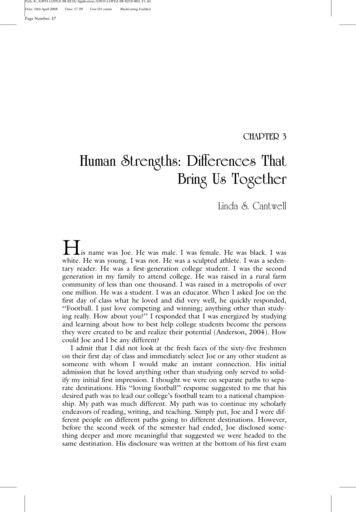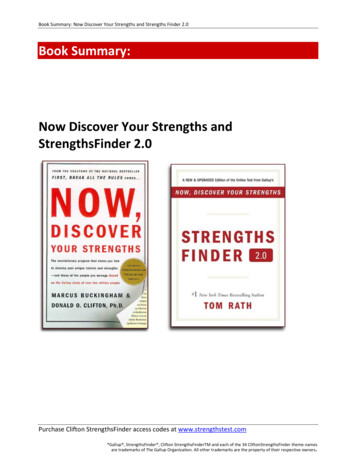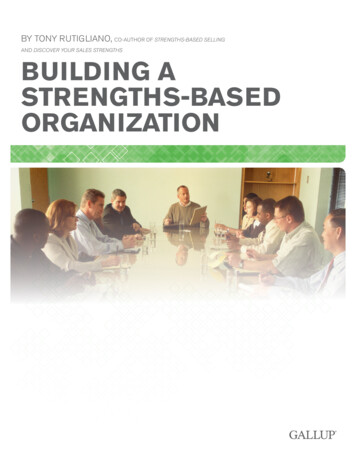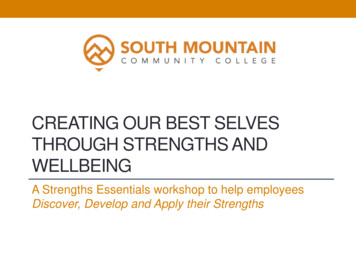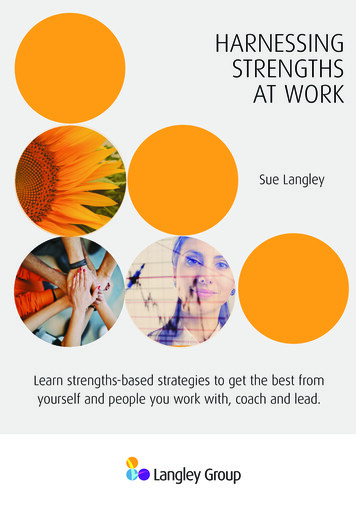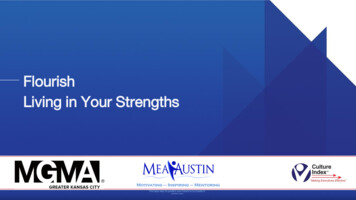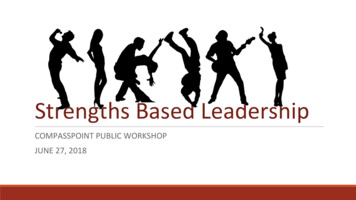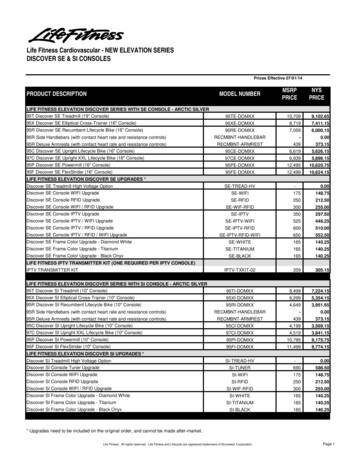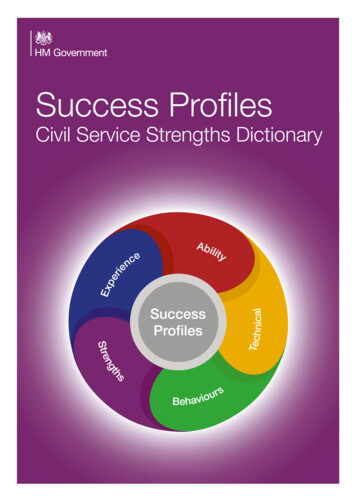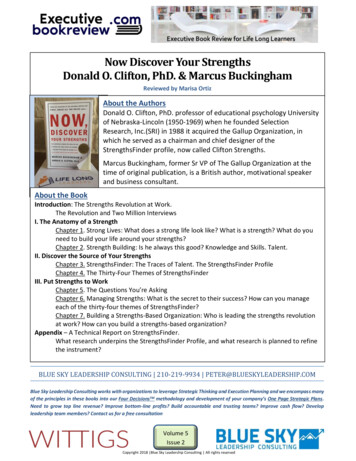
Transcription
Now Discover Your StrengthsDonald O. Clifton, PhD. & Marcus BuckinghamReviewed by Marisa OrtizAbout the AuthorsDonald O. Clifton, PhD. professor of educational psychology Universityof Nebraska-Lincoln (1950-1969) when he founded SelectionResearch, Inc.(SRI) in 1988 it acquired the Gallup Organization, inwhich he served as a chairman and chief designer of theStrengthsFinder profile, now called Clifton Strengths.Marcus Buckingham, former Sr VP of The Gallup Organization at thetime of original publication, is a British author, motivational speakerand business consultant.About the BookIntroduction: The Strengths Revolution at Work.The Revolution and Two Million InterviewsI. The Anatomy of a StrengthChapter 1. Strong Lives: What does a strong life look like? What is a strength? What do youneed to build your life around your strengths?Chapter 2. Strength Building: Is he always this good? Knowledge and Skills. Talent.II. Discover the Source of Your StrengthsChapter 3. StrengthsFinder: The Traces of Talent. The StrengthsFinder ProfileChapter 4. The Thirty-Four Themes of StrengthsFinderIII. Put Strengths to WorkChapter 5. The Questions You’re AskingChapter 6. Managing Strengths: What is the secret to their success? How can you manageeach of the thirty-four themes of StrengthsFinder?Chapter 7. Building a Strengths-Based Organization: Who is leading the strengths revolutionat work? How can you build a strengths-based organization?Appendix – A Technical Report on StrengthsFinder.What research underpins the StrengthsFinder Profile, and what research is planned to refinethe instrument?BLUE SKY LEADERSHIP CONSULTING 210-219-9934 PETER@BLUESKYLEADERSHIP.COMBlue Sky Leadership Consulting works with organizations to leverage Strategic Thinking and Execution Planning and we encompass manyof the principles in these books into our Four DecisionsTM methodology and development of your company’s One Page Strategic Plans.Need to grow top line revenue? Improve bottom-line profits? Build accountable and trusting teams? Improve cash flow? Developleadership team members? Contact us for a free consultationVolume 5Issue 2Copyright 2018 Blue Sky Leadership Consulting All rights reserved
Introduction:We wrote this book to start a revolution, the strengths revolution. (pg5)The great organization must not only accommodate the fact that each employee is different, it must capitalize onthese differences. (pg5)The two assumptions that guide the world’s best managers:1. Each person’s talents are enduring and unique2.Each person’s greatest room for growth is in the areas of his or her greatest strength. (pg8)These thirty-four are the most prevalent themes of human talent In their many combinations, can do the best jobof explaining the broadest possible range of excellent performance. These signature themes are your mostpowerful sources of strength. The real tragedy of life is not that each of us doesn’t have enough strengths, it’s thatwe fail to use the ones we have. (pg 12)I. The Anatomy of Strength – Strong livesThe secret to their success lies in the ability to discover their strengths and to organize their life so that thesestrengths can be applied. (pg22) Strength: consistent near perfect performance in an activity. For an activity to bea strength you must be able to do it consistently. You do not have to have strength in every aspect of your role toexcel. (pg 25)That excellent performers must be well rounded is one of the most pervasive myths we hope to dispel in thisbook. When we studied them, excellent performers were rarely well rounded. On the contrary, they were sharp.They found ways to manage around their weaknesses, thereby freeing them up to hone their strengths to asharper point. (pg26)The three revolutionary tools you will need to build a strong life:1. Understanding how to distinguish your natural talents from things you can learn. (pg28)Talents are your naturally recurring patterns of thought, feeling, or behavior. Your various themes of talent arewhat the StrengthsFinder profile actually measures. Knowledge consists of the facts and lessons learned.Skills are the steps of an activity. These three-talents, knowledge, and skills – combine to create your Strengths.(pg29)2. A system to identify your dominant talents. StrengthsFinder will shine a spotlight on them. It will be upto you to perform. (pg32)3. A common language to describe your talents. It must be positive; it must help us explain strength, notfrailty. And it must be common; it must be a language in which we are all fluent so that no matter who we are orwhere we are from, we all know exactly what is meant when someone says, “Marcus embodies Command” or“Don exhibits Achiever.” (pg32)There are two distinct kinds of knowledge: factual knowledge, which is content. It won’t guarantee excellence, butexcellence is impossible without it. The second kind of knowledge you need is experiential, which isn’t taught inclassrooms or found in manuals and it takes a multitude of forms. (pg42)Every environment offers chances to learn. Some experiential knowledge is more conceptual for example yourvalues and your self-awareness. (pg43)Book Review: Now Discover Your StrengthsPage 2 7Volume 5Issue 2
Skills bring structure to experiential knowledge. (pg45) Skills are to enticingly helpful that they obscure their twoflaws. The first flaw is that while skills will help you perform, they will not help you excel. (pf46) The second flaw isthat some activities, almost by definition, defy being broken down into steps.A skill is designed to make the secrets of the best easily transferable. If you learn a skill, it will help you get a littlebetter, but it will not cover for a lack of talent. Instead, as you build your strengths, skills will actually prove mostvaluable when they are combined with genuine talent. (pg47)Your recurring patterns are created by the connections in your brain; and no, beyond a certain age you are notgoing to be able to stitch a completely new design-your talents are enduring. (pg49) Put more plainly, yoursynapses create your talents. By the time you wake up on your sixteenth birthday, half your network is gone.(pg51)Nature and nurture reinforce some connections and allow billions of others to fade away. And so you emerge-adistinctly talented individual blessed/or cursed to react to the world in your own enduringly unique way. Ourtalents come so easily to us that we acquire a false sense of security. On some level it is quite comforting tobelieve that the “sense” we make of the world is “common” to everyone. (pg53)Skills determine if you can do something, whereas talents reveal something more important: how well and howoften you do it.Damage control versus development: damage control can prevent failure, but it will n ever elevate you toexcellence. (pg58) The danger of repetitive training without underlying talent is that you burn out before you netany improvement. (pg59)Most organizations, with their heavy emphasis on weakness fixing, ignore how deadening it can be. (pg60)Your talents, your strongest synaptic connections, are the most important raw material for strength building.Identify your most powerful talents, hone them with skills and knowledge, and you will be well on your way toliving the strong life. (pg61)II. Discover the Source of Your StrengthsIf you want to reveal your talents, monitor your spontaneous, top-of-mind reactions to situations you encounterthey provide the best trace of your talents. They reveal the location of strong mental connections. (pg67)Your yearnings reflect the physical reality that some of your mental connections are simply stronger than others.Rapid learning offers another trace of talent. Satisfactions provide the last clue to talent. If it feels good when youperform an activity, chances are that you are using a talent. (pg73)You are better served by tuning your antenna toward identifying those positive activities that seem to bring yourpsychological strength and satisfaction. We are all woven so uniquely that each of us experiences slightly differentsatisfactions. (pg 74)Book Review: Now Discover Your StrengthsPage 3 7Volume 5Issue 2
StrengthsFinder Profile: measures the 34 themes of talent that we discovered during our own study of excellence.Your five most dominant themes of talent, your signature themes. These may not yet be strengths. Each theme isa recurring pattern of thought, feeling and behavior- the promise of a strength. (pg79)The Thirty-Four Themes of StrengthsFinderAchiever * Activator * Adaptability * Analytical * Arranger * Belief * Command * Communication * Competition *Connectedness * Context * Deliberative * Developer * Discipline * Empathy * Fairness (Consistency) * Focus *Futuristic * Harmony * Ideation * Inclusiveness (Includer) * Individualization * Input * Intellection * Learner *Maximizer * Positivity * Relator * Responsibility * Restorative * Self-Assurance * Significance* Strategic * WOOIII. Put Strengths to WorkThe questions you are asking. Are there any obstacles to building my strengths?The truth is that many people are reluctant. Many people don’t concern themselves with the intricacies of theirstrengths; instead, they choose to devote their time and energy to investigating their weaknesses. (pg121)In every culture the group least fixated on their weaknesses was the oldest group, those fifty-five years old andabove. A little older, a little wiser, this group has probably acquired a measure of self-acceptance and realized thefutility of trying to paper over the persistent cracks in their personality.The three basic fears: fear of weaknesses, fear of failure, and, fear of one’s true self.Our fear of weaknesses seems to overshadow our confidence in our strengths. Most of us assume that ourweaknesses trump our strengths. (pg122)Whatever the weakness, whatever the strength, the strength is just a strength-to be admired and then simplyassumed- but the weakness, ah, the weakness is an “area of opportunity.” This fixation with weakness is deeplyrooted in our education and upbringing. This weakness orientation persists in the fields of research and academia.Criticism has “the power to do good when there is something that must be destroyed, dissolved or reduced, but [itis} capable only of harm when there is something to be built.” Carl Jung 1930s. (pg124)But building on your strengths isn’t necessarily about ego. It’s about responsibility. It is your opportunity to takeyour natural talents and transform them through focus and practice and learning into consistent near perfectperformance. The most responsible, the most challenging and, in the sense of being true to yourself, the mosthonorable thing to do is to face up to the strength potential inherent in your talents and then find ways to realizeit. (pg126)“Fidelity to the law of your own being is an act of high courage flung in the face of life.” Carl Jung (pg.127)“To be what we are, and to become what we are capable of becoming, is the only end of life. Baruch Spinoza(pg128)Book Review: Now Discover Your StrengthsPage 4 7Volume 5Issue 2
Will I become too narrow if I focus on my signature themes? You will actually become stronger, more robust, moreopen to new discoveries and, more importantly, more appreciative of people who possess themes very differentfrom your own. Unsure of who we really are, we define ourselves by the knowledge we have acquired or theachievements we have racked up along the way we become reluctant to change careers or learn new ways ofdoing things because then, in the new career, we would be forced to jettison our precious haul of expertise andachievement. We would have to jettison our identity. (pg144)Unsure of who we really are, we become reluctant to investigate who others really are. Our uncertainty aboutourselves limits our inquisitiveness about other things. No matter what your choice of profession, no matter whatthe trajectory of your career, if you are applying and refining and polishing your top five themes, then you areindeed living your life. Living the life you were supposed to live. (pg145)How can I manage around my weaknesses? A weakness is anything that gets in the way of excellent performance.1. Get a little better at it2. Design a support system3. Use one of your strongest themes to overwhelm a weakness4. Find a partner5. Stop doing itA person can never have too much of a particular theme. He can only have not enough of another one. (pg159)You need to be careful about drawing too straight a line between a particular theme and a particular role. Ourresearch interviews indicate that thousands of people with very different theme combinations nonetheless playthe same role equally well. (pg165)Can my themes reveal whether I am in the right career? No matter what the role, there are many routes toexcellence. Our research into human strengths does not support the extreme, and extremely misleading, assertionthat “you can play any role you set your mind to,” but it does lead us to this truth: Whatever you set your mind to,you will be most successful when you craft your role to play to your signature talents most of the time. (pg167)If you are to keep your talented employees and spur each of them into greater performance, you will have todiscern how each one is unique and then figure out ways to capitalize on this uniqueness. (pg174)One by One – How to Manage a Person Strong in all 34 themes guide for Managers. (pg.177-210)Building a Strengths-based Organization1.2.3.4.Spend a great deal of time and money selecting people properly in the first place.Focus performance by legislating outcomes rather than forcing each person into a stylistic mold.Focus your training time and money on educating people about their strengths and figuring out waysto build on these strengths rather than on remedially trying to plug their “skill gaps.”Devise ways to help each person grow their careers without necessarily promoting them up thecorporate ladder and out of their areas of strength. (pg216)A systematic process for maximizing the value locked up in your human capital. Much of the responsibility will liewith the manager to select for talent, set clear expectations, focus on strengths, and develop each employee’scareer. (pg217)Book Review: Now Discover Your StrengthsPage 5 7Volume 5Issue 2
The Practical Guide – How can you build a strengths-based organization?1. The Strengths-based Selection Systema. Build selection system around an instrument of measuring talentb. Calibrate your instrument by studying your best performers in each key role.c. Teach the talent language throughout the organization.d. Build a theme profile of your entire company.e. Study the links between measured talent and subsequent performance.2. The Strengths-based Performance Management System - Focus and develop talents into measurableperformancea. Impact on the business – figure out the right way to measure the desired performance.b. Impact on the external/internal customer. Design a simple way to measure the emotionaloutcomes you want to create in your customers.c. Impact on the employees around her/him.i. Gallup Engagement Survey Q12 for Manager to Employee relationship.ii. Employee-Employee relations surveyiii. Ensure that every manager has a strengths discussion with every employee.If you want to keep a talented employee, show him not just that you care about him, not just that you will helphim grow, but, more important, that you know him, that in the truest sense of the word you recognize him (or, atthe very least, that you are trying to). (pg237)The best mechanism for channeling the employee’s path toward performance must, by definition be, regular,predictable, and productive meetings with his immediate manager. (pg237)3. The Strengths-based Career Development System. - People can learn, grow their careers, and receivepraise for good work without getting promoted.Our great error is thinking that all human beings crave the same kind of prestige- the prestige that comes withpower. In our knowledge economy where, specialized expertise and individualized customer relationships areprized, the chances are that the employees know more about their particular field or customer than their managerdoes, and thus the threat that he has power over his decisions, judgement and discretion loses much of its force.Anyone who is excelling in her role deserves prestige. Many kinds of prestige should be available to reflect themany different near perfect performances the organization wants to encourage. (pg241)Your organization must build more ladders. Give people incentives to climb the rungs (pg242)The more prestige your organization offers, the healthier your employees will be. Employees who strongly agreedthat they had a chance to do what they do best every day claimed fewer sick days, filed fewer workers’compensation claims, and had fewer accidents while on the job. (pg244)Book Review: Now Discover Your StrengthsPage 6 7Volume 5Issue 2
Our FacultyActionsWhat thought, or idea had the biggest impact on you today?What is one specific action you will take TODAY from what was discussed?HOW will you implement this action?Volume 5Issue 2Copyright 2018 Blue Sky Leadership Consulting All rights reserved
Jan 01, 2018 · StrengthsFinder profile, now called Clifton Strengths. Marcus Buckingham, former Sr VP of The Gallup Organization at the time of original publication, is a British author, motivational speakerFile Size: 1MB
